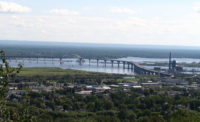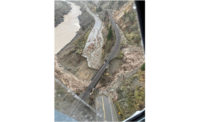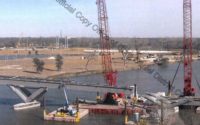Cost of Crane Insurance Likely To Rise After Accident
Higher limits could be sought on coverage, say brokers and insurers.

This photograph, of a safely operated crane used in construction of the Manitoba Hydro headquarters in Winnipeg, was a 2008 Images of the Year winner. Photographer: Evan Fuller, PCL Constructors Canada Ltd.
Firms that own and operate construction cranes could face more costly insurance renewals after the Feb. 5 crawler-crane collapse in New York City that killed a Wall Street trader and crushed a row of cars.
Based on past practices, project contractors working in major urban areas are likely to insist that crane operators and owners beef up their coverage, including higher ceilings on payouts for claims, according to some brokers and insurers.
The cause of the Feb. 5 accident remains under investigation. In response, New York City tightened its crane safety regulations to require operators to stop work when sustained winds reach 20 mph or gusts peak at 30 mph.
No isolated incident, the recent collapse in lower Manhattan is the latest high-profile crane accident over the past few years that have proven costly, not just for crane operators but also for contractors, project owners and developers.
In particular, there is concern about so-called “drop-down coverage,” which occurs when damages from a crane collapse burn through the liability policies held by crane companies and leave, leaving contractors and building owners holding claims.
“We saw a significant ratcheting up after 9/11,” notes Robert C. Kirkwood, a partner in Kirkwood Insurance, based in the New York City suburb of Pleasantville, N.Y. He anticipates risk-management committees at the city’s major tower developers and owners will lead the way in boosting insurance requirements.
Crane operators are already skittish, according to some involved in crane insurance.
Jake Morin, program executive for insurer ProSight’s construction and casualty practices, has fielded a number of calls from operation firms in the days since the Feb. 5 crane collapse that are concerned about whether they are adequately covered.
“A lot of people are looking at this and saying, ‘I do that job every single day,’ ” Morin noted. “They are waking up in the morning and saying, ‘Holy cow, I was doing the same thing, and I was in Chicago.’ ”
ProSight, based in Morristown, N.J., provides specialized coverage to construction managers, as well as crane operators and owners.
Subs Required to Buy More
In general, prime contractors typically have responded to major catastrophes by boosting the amount of insurance they require subs to carry, notes Kirkwood.
Contractors on some midtown New York City construction projects are starting to require $15 million to $20 million in insurance coverage from their crane operators, up from the current standard of $10 million, he says.
Going to $25 million from $10 million probably could add another 30% to 40% to annual liability insurance premiums, Kirkwood says. He also expects that New York City will look at raising the amount of insurance coverage it currently requires for a crane license.
Few have forgotten the Manhattan crane accidents of 2008.
That year, a pair of tower crane collapses in New York City claimed a total of nine lives. In another incident in 2012 during Superstorm Sandy that didn’t result in a collapse, part of a crane dangled above a busy midtown Manhattan street, prompting the evacuation and shutdown of nearby buildings.
“That obviously would have been very, very devastating,” Kirkwood says of that crane drama. “It almost begs the question of what is the right amount of liability coverage.”
Damage Drives Claims
Along with the potential for the loss of human life, urban crane collapses can devastate nearby buildings, cause major delays in a construction project and shut down local businesses. Each of these situations can trigger multimillion-dollar claims—and that’s before the cost of cleaning up and carting away the rubble.
A loss of $250 million isn’t outside the scope of the imagination, Kirkwood says. Insurers sometimes refer to these types of accidents as creating “shock-loss exposure.” To risk managers, a crane accident is a low-frequency, high-impact event.
Still, with few large crane owners in New York City, there are limited options for negotiating insurance coverage and other issues, notes Pia E. Riverso, a partner at RivkinRadler, a law practice based in Uniondale, N.Y.





